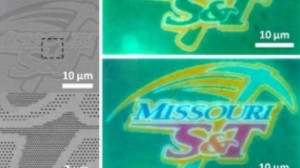Taking advantage of the unique light absorbing properties of plasmonic metatamaterials, researchers have printed color images using nanoscale holes instead of ink.
Using nanometer-size metamaterials, researchers at Missouri University of Science and Technology have developed a technique to print images that uses the manipulation of light, rather than the application of ink, to produce colors. This “no-ink” printing method has been demonstrated by producing a Missouri S&T athletic logo just 50 micrometers wide.
In normal color printing, various semi-transparent inks are applied on top of each other to produce the various hues of a picture. In the technique developed by Missouri S&T, instead of ink, microminiature perforations are made in a multi-layered structure consisting of two thin films of silver separated by a film of silica 45 nanometers thick. The uppermost layer of silver film, just 25 nanometers deep, is punctured with miniscule holes using a focused ion-beam milling microfabrication process.
Using this process, the researchers created holes with different diameters (ranging in size from 45 to 75 nanometers) corresponding to the desired absorption of light at various wavelengths. As such, light shining onto the logo at specific frequencies allowed researchers to create different colors with reflected light instead of ink. This nano-scale “color palette” meant that the physical characteristics of the holes in the material determined the color displayed to accurately reproduce the S&T athletic logo.
“Unlike the printing process of an inkjet or laserjet printer, where mixed color pigments are used, there is no color ink used in our structural printing process – only different hole sizes on a thin metallic layer,” said Dr. Jie Gao, assistant professor of mechanical and aerospace engineering at Missouri S&T.
The nanoscale perforations used to provide this color are so small as to only be visible with the help of an electron microscope, but they allowed the researchers to reproduce the standard colors of the S&T logo, and also to manipulate the light to produce four new colors to make an orange ampersand, a navy blue “Missouri”, a magenta “S” and “T”, and a cyan pickaxe symbol.
As the sandwiched silver/silica material acts as a plasmonic device, the Missouri S&T team believes that mechanical color printing on such materials provides a much higher printing resolution than conventional color printing. This is because their research shows that the periodic holes on the surface of the silver film provides excitation of surface-plasmon polaritons (electromagnetic waves that travel along the surface of a metal-dielectric or metal-air interface) and create an optical magnetic dipole resonance which results in near-perfect light absorption and negligible reflection in the material.
As a combination of substances that provide functions or phenomena that act in ways not yet found in nature, the printing substrate is also a metamaterial. As such, its unique properties may allow it to be used in ways not previously possible in the areas of nanoscale visual arts, security tagging, and information storage. The researchers also believe that such a method of printing should also result in a reduced material count in relation to standard printing methods, and could lead to lower costs, easier recycling, and higher fidelity and stability in image reproduction.
References:

